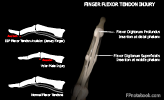II. Mechanism
- Volar plate injured in forced hyperextension of affected joint
- Usually affects PIP joint
- Partial or complete tear or avulsion Fracture
- Often occurs when the finger is dislocated dorsally
- Associated with PIP Collateral Ligament Injury
- Images
III. Signs
- Tenderness at affected joint at volar aspect
- Evaluate collateral ligaments for stability
- Range of motion remains intact if stable joint
IV. Imaging: XRay
- Avulsion Fracture may be present
V. Management
- Referral indications
- Unstable joint
- Large avulsion Fracture
- Moderate, but stable injury (most cases)
- Progressive extension splint (block splint) of both PIP and DIP joints
- Aluminum splint initially angled 30 degrees flexion
- Progressively decrease flexion weekly by 5-10 degrees
- Week 1-2: 30 degrees
- Week 2-3: 20 degrees
- Week 3-4: 10 degrees
- Week 4: Full extension
- Buddy taping for an additional 2 weeks
- Mild injury
- Buddy taping to adjacent finger for 4 weeks
- Sport participation
- May participate if splinted or buddy taped
VI. Complications
- Hyperextension deformity (Swan-Neck deformity)
VII. References
- Leggit (2006) Am Fam Physician 73(5):810-23 [PubMed]
- Mercier (1995) Practical Orthopedics, p. 314

